How To Repair Small Hole In Drywall Ceiling
How to Repair Ceiling Holes
Ceiling holes present a particular challenge when attempting to do repairs. Because gravity will pull down on the patching material as information technology dries, a burl can develop in the surface and cause an unsightly finish when you're washed. If yous have a big ceiling hole of more than half dozen or 7 inches to repair, you should use the process at this link to do it.
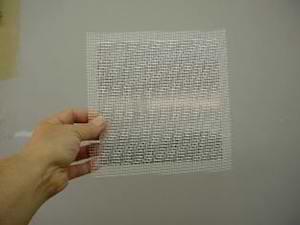
If you're dealing with a smaller ceiling pigsty, you can use a cocky-sticking, aluminum reinforced patch like the one shown here for a quick, easy repair procedure. A drywall patch similar this tin be found just about anywhere wall repair materials are bachelor. These are basically fiberglass-mesh over a thin slice of perforated aluminum. They come in a few sizes starting at nearly 4 inches and going up to viii or 10 inches. These are self-sticking so you just have to apply it over the hole, sticking information technology to the surrounding surface and so embrace the whole area with a few coats of articulation compound.
What You'll Need to Repair a Ceiling Hole
- An Aluminum Reinforced Patch
- Articulation Compound
- A Joint Knife
- A Mud Pan
- Sandpaper
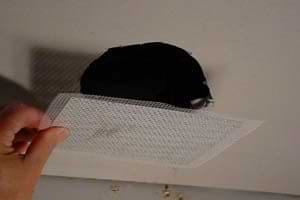
Measure the hole to be covered and get a patch that measures a couple inches more than than that. An inch overlap on each side of the opening should be enough to brand the patch work as intended. Be sure the ceiling surface around the hole is smooth and free of dust or other contaminants before applying the patch. If you have h2o impairment or other stains, seal that showtime with a primer/sealer and permit information technology dry earlier applying the patch.
Apply a Showtime Coat of Mud
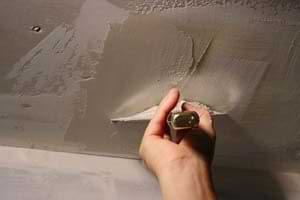
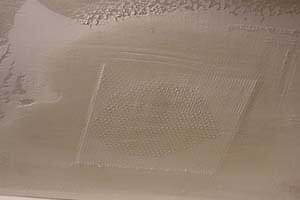
Using setting compound, also called mud, for this chore volition make for the best possible result but ready-mixed compound will work likewise and information technology won't require mixing. It will, however, take longer to practise the chore because the gear up-mixed compound will accept longer to dry.
Get-go past applying a thick glaze of mud over the whole patch, overlapping onto the surrounding ceiling by a few inches on all sides. Immediately go dorsum over the mud with the joint pocketknife to skim off the backlog, leaving a very thin layer over the patch and the surrounding ceiling.
This first glaze is just intended to make full in the mesh and start to alloy the surface into the ceiling material so don't await it to hide the patch. Ignore whatsoever ridges in the surface left past the knife bract or other roughness in the mud as you skim, these volition exist removed subsequently. Let the mud dry completely.
Apply A 2nd Coat of Mud
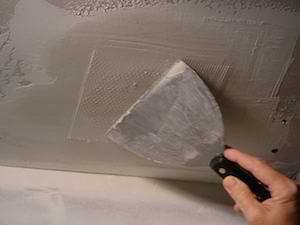
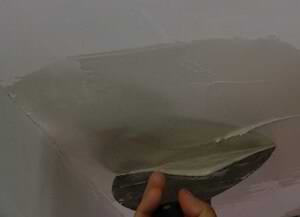
When the first coat has set and dried, utilise the joint pocketknife in a forward stroke to shave off any ridges or bumps in the surface of the mud. Lightly sand the edges effectually the perimeter to blend it with the existing ceiling pigment. Gently wipe off the sanding grit with a damp textile earlier proceeding.
Utilise another coat of mud over the whole patch, overlapping the edges of the first mud coat and spreading out onto the surrounding ceiling. Every bit with the first coat, use excess mud start and then skim it off to go out a smooth end.
Stroke with the joint knife perpendicular to the direction you used with the get-go coat. If you stroked east to west with the outset coat, stroke n to s with this one. This volition assist to achieve an overall level finish in the repair surface and to hide the edges of the aluminum. Permit the mud dry completely and shave/sand as necessary to remove any roughness in the surface before wiping the dust abroad.
Apply a Final Coat
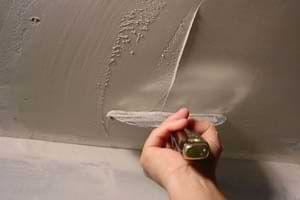
Apply a tertiary and final glaze of mud to cover the whole patch, once more, overlapping the previous mud coat and spreading out onto the surrounding ceiling. Employ the same process of thick coat followed by skimming. Again, skim with perpendicular strokes to the previous coat.
Alternating your strokes should have tapered the aluminum edges into the existing surface making them invisible at this point. If that didn't happen and you tin can yet see the metal showing through the mud, yous will demand to apply another coat to embrace it. Employ a bit of fresh mud over the visible metal and stroke parallel over the edge to blend it with the rest of the repair surface.
Touch Upward the Paint
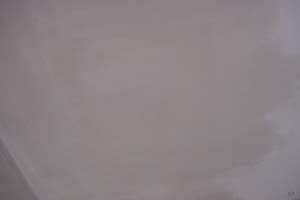
Let the final glaze of mud dry completely before attempting to sand it and touch upward the paint. Use a light impact to sand the whole expanse giving extra attention to the edges to blend them with the existing ceiling pigment.
To terminate, brush away the sanding dust and lightly wipe off the residue with a damp rag before touching up the paint. If your end paint is flat latex, information technology volition be self-priming. If yous're using semi-gloss, oil-based, or another shiny paint finish, prime the patch with a latex primer or other flat latex paint starting time.
- How to Repair Bubbling Paint
- How to Repair Torn Drywall Newspaper
- Repairing Water Damaged Drywall
- Repairing Water Damaged Plaster
- Repairing Crumbling Plaster
- Repairing Major Plaster Damage
- Repairing Wood Lath Plaster
- Repairing Drywall Nail Pops
- Repairing Small-scale Wall Holes
- Repairing Large Wall Holes
- Repairing Large Ceiling Holes
- Repairing Small Ceiling Holes
- Repairing Wall and Ceiling Cracks
- Repairing Cracks with Expanding Foam
- Installing a Drywall Ceiling
- Finishing Recessed Drywall Joints
- Finishing Metal Drywall Corner Bead
- Finishing Newspaper Corner Bead
- Finishing Within Drywall Corners
- Finishing Drywall Butt Joints
- How to Exercise Drywall Texturing
- Skim Coating on Walls and Ceilings
- Sanding Drywall Joint Compound
- Wall Tools and Materials Guide
How To Repair Small Hole In Drywall Ceiling,
Source: https://www.do-it-yourself-help.com/how-to-repair-ceiling-holes.html
Posted by: horstdinted1954.blogspot.com


0 Response to "How To Repair Small Hole In Drywall Ceiling"
Post a Comment